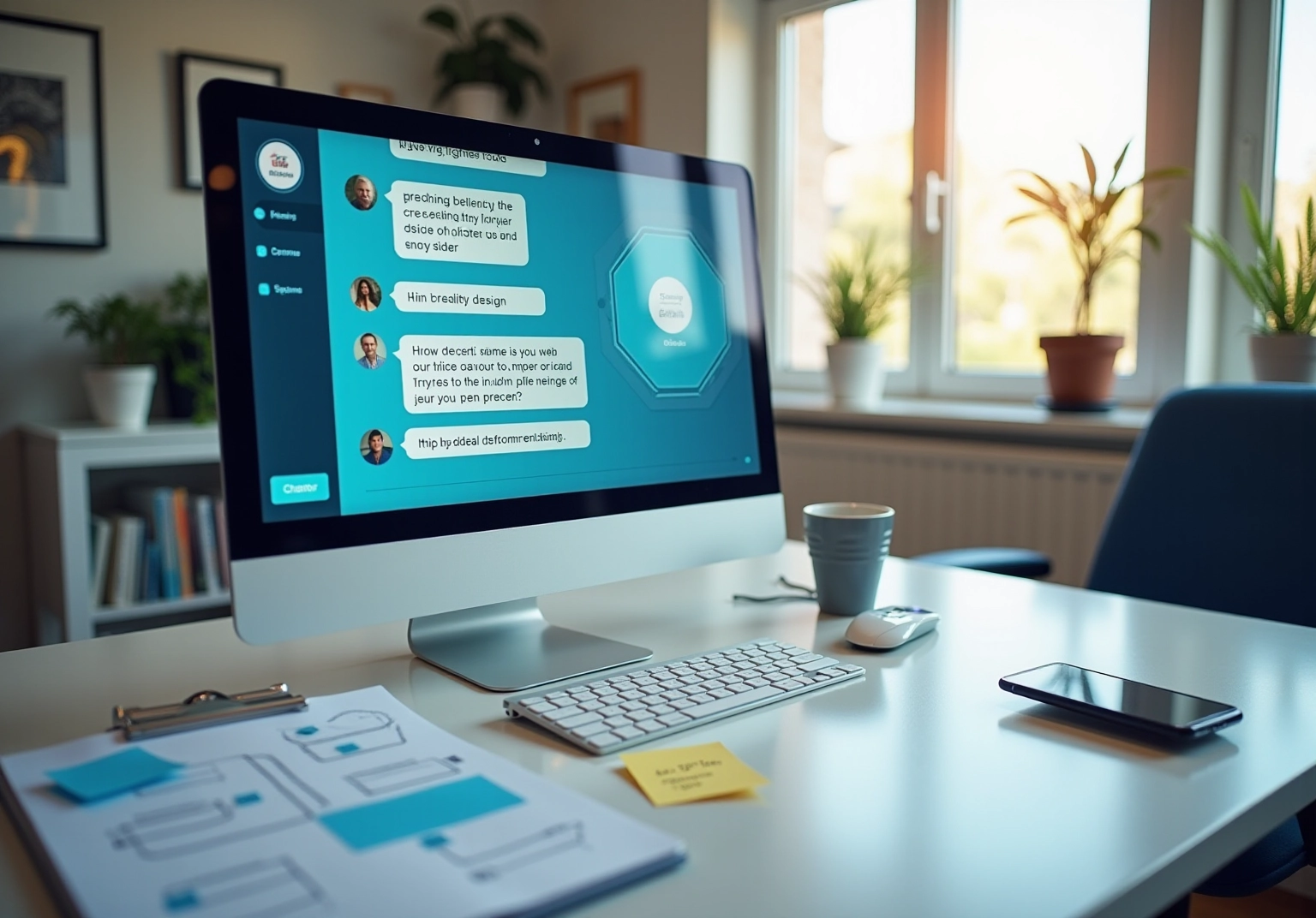
Build a Custom AI Chatbot: Step-by-Step Guide for Sales Directors
GeneralOverview
This article offers a comprehensive, step-by-step guide for Sales Directors on building a custom AI chatbot. It emphasises the critical importance of:
- Defining use cases
- Designing conversation flows
- Integrating essential tools
Supporting this guidance is compelling data that highlights the effectiveness of chatbots in enhancing customer engagement and operational efficiency. For instance, a striking statistic reveals that 90% of companies report faster resolution of queries through chatbots. This underscores the value of chatbots in modern sales strategies, making a strong case for their integration into business practises.
Introduction
The rise of AI chatbots is revolutionising customer engagement, providing businesses with innovative avenues to connect with clients and streamline operations. Sales directors are at the forefront of this transformation, facing a unique opportunity to leverage these advanced technologies to enhance lead qualification and customer support. Yet, building a custom AI chatbot presents its own set of challenges—how can sales leaders guarantee that their virtual assistants not only meet customer expectations but also drive substantial business outcomes? This pivotal moment calls for strategic action to harness the full potential of AI solutions.
Understand the Basics of AI Chatbots
AI conversational agents represent a remarkable evolution in software applications, simulating human interaction through advanced natural language processing (NLP) and machine learning (ML). These technologies empower virtual assistants to carry out a diverse array of tasks, including:
- Addressing customer inquiries
- Qualifying leads
- Delivering product information
Understanding the distinction between transactional and conversational automated systems is crucial for effective implementation. Transactional virtual assistants are engineered to execute specific tasks, such as processing orders or scheduling appointments, whereas conversational agents foster more fluid and natural dialogues, significantly enhancing user experience.
Beginning in 2025, a significant number of enterprises are expected to adopt custom AI chatbots for client support, underscoring the growing reliance on these tools to streamline operations and elevate user interactions. Industry leaders emphasise the importance of recognising the various types of automated conversation agents to tailor solutions that meet specific business needs. By harnessing NLP and ML, chatbots can comprehend and respond to user inputs with greater efficacy, rendering them indispensable assets in contemporary customer service strategies. Familiarising yourself with these concepts will empower you to define the purpose and scope of your virtual assistant, ensuring alignment with your organisational objectives.
Gather Required Tools and Resources
To establish your custom AI chatbot, selecting the right platform is crucial. Consider popular options like:
- Dialogflow
- Microsoft Bot Framework
- Botpress
These platforms are widely recognised for their capabilities. Furthermore, explore tools for natural language processing, such as:
- IBM Watson
- Rasa
These can enhance your agent’s performance. Ensure you have access to a reliable development environment, whether through a cloud service or a local server, and gather any necessary APIs for seamless integration. By familiarising yourself with the documentation of these tools, you can significantly streamline the development process, paving the way for a successful implementation.
Follow Step-by-Step Instructions to Build Your Chatbot
- Define your use case for the custom AI chatbot by clearly identifying its primary function, whether it be lead qualification or customer support. This clarity will serve as a guiding principle throughout your design and development process. Notably, 35% of enterprises utilising conversational agents operate in the B2B sector, underscoring their effectiveness in engaging with key decision-makers.
- Design the Conversation Flow: Strategically map out the interactions that will take place. Employ flowcharts to visually represent participant paths and responses. The design of an effective conversation flow is crucial; automated systems can resolve 83% of queries independently, significantly enhancing the user experience.
- Build the Knowledge Base: Equip your virtual assistant with pertinent information, frequently asked questions, and tailored responses for your audience. A well-organised knowledge base can dramatically boost customer satisfaction, with 90% of companies reporting faster resolutions through chatbots.
- Develop the Virtual Assistant: Using your selected platform, initiate the construction of your virtual assistant by configuring intents, entities, and responses in alignment with your conversation flow. Incorporating AI-driven personalization can yield a 20% increase in sales, making this step essential.
- Integrate APIs: If applicable, incorporate third-party APIs to enhance functionality, such as CRM systems for lead management. This integration can streamline processes and elevate operational efficiency.
- Test Your Virtual Assistant: Undertake comprehensive testing to ensure the virtual assistant accurately and effectively responds to user inputs. Utilise real-world scenarios to validate its performance. Keep in mind that 64% of customers value 24/7 service, a capability that chatbots can readily provide.
- Deploy and Monitor: After testing is complete, deploy your chatbot across your chosen channels (website, social media, etc.) and monitor its performance to implement necessary adjustments. Continuous monitoring is vital to optimise user interactions and guarantee high-quality conversations.
By adhering to these steps, Sales Directors can effectively leverage chatbots to enhance customer engagement and operational efficiency, ultimately driving superior business outcomes.
Troubleshoot Common Issues During Development
Common issues during chatbot development are critical to address for optimal performance:
-
Misunderstanding Participant Intent: To effectively train your chatbot, it is essential to provide a diverse set of examples that capture the various ways individuals might phrase their questions. This method significantly enhances its capability to identify and react precisely to inquiries.
-
Technical Glitches: Regular testing across different environments is crucial for identifying and resolving bugs. Implementing logging systems to monitor errors and interactions enables prompt fixes and enhancements, ensuring a seamless user experience.
-
Limited Knowledge Base: Continuously updating your virtual assistant’s knowledge base with new information and user feedback is vital. This practise not only enhances response precision but also ensures that the virtual assistant remains relevant and beneficial over time.
-
Integration Problems: If your chatbot struggles to connect with other systems, it is imperative to verify API keys and permissions. Ensuring that all integrations are correctly configured facilitates seamless communication between platforms, enhancing overall functionality.
-
Participant Frustration: Closely observing participant interactions and collecting feedback allows you to identify areas where individuals may face challenges. Analysing this data enables you to improve conversation flows and enhance the overall experience. Notably, 65% of users prefer addressing inquiries without human assistance, underscoring the necessity for a custom ai chatbot as an efficient automated response system. Furthermore, 53% of clients abandon their support requests within the first 10 minutes of waiting for an agent, emphasising the need for quick response times. Incorporating key performance indicators (KPIs) such as goal completion rate and customer satisfaction can further guide improvements in chatbot effectiveness.
Conclusion
Building a custom AI chatbot is not just an option; it is an essential strategy for sales directors aiming to enhance customer engagement and streamline operations. By grasping the fundamentals of AI chatbots, selecting the right tools, and adhering to a structured development process, businesses can create effective virtual assistants tailored to their specific needs. This approach not only improves user experience but also drives significant business outcomes.
Key steps have been outlined throughout the article, including:
- Defining the chatbot’s purpose
- Designing conversation flows
- Developing a robust knowledge base
- Integrating necessary APIs
Each of these stages plays a crucial role in ensuring that the chatbot can efficiently handle customer inquiries and support tasks. Addressing common development challenges, such as understanding participant intent and maintaining an updated knowledge base, is vital for optimising performance and user satisfaction.
Ultimately, the integration of custom AI chatbots into sales strategies represents a forward-thinking approach that leads to increased efficiency and customer loyalty. As customer expectations evolve, leveraging these technologies will not only keep businesses competitive but also foster deeper connexions with clients. Embracing this transformative tool is a necessity for sales directors determined to thrive in a rapidly changing marketplace.
Frequently Asked Questions
What are AI chatbots?
AI chatbots are software applications that simulate human interaction using advanced natural language processing (NLP) and machine learning (ML) technologies.
What tasks can AI chatbots perform?
AI chatbots can address customer inquiries, qualify leads, and deliver product information.
What is the difference between transactional and conversational automated systems?
Transactional virtual assistants are designed to execute specific tasks, such as processing orders or scheduling appointments, while conversational agents facilitate more fluid and natural dialogues to enhance user experience.
When are enterprises expected to start adopting custom AI chatbots for client support?
Beginning in 2025, many enterprises are expected to adopt custom AI chatbots for client support.
Why is it important to understand the different types of automated conversation agents?
Understanding the various types of automated conversation agents is crucial for tailoring solutions that meet specific business needs and for effective implementation.
How do NLP and ML enhance the functionality of chatbots?
By utilising NLP and ML, chatbots can comprehend and respond to user inputs more effectively, making them essential tools in modern customer service strategies.
How can organisations ensure their virtual assistant aligns with their objectives?
Familiarising oneself with the concepts of AI chatbots will help define the purpose and scope of the virtual assistant, ensuring it aligns with the organisation’s objectives.
Enjoyed this post? Share it with your network!
10 Best AI Sales Tools to Boost Your Team’s Performance

Discover the top 10 best AI sales tools to enhance team performance and drive revenue growth.
Mastering Test Call Numbers: A Step-by-Step Guide for Sales Directors

Elevate your communication with our guide on mastering test call numbers for sales success.
7 Ways Automated Outbound Calls Boost Sales Performance

Discover how automated outbound calls enhance sales performance and streamline communication.
